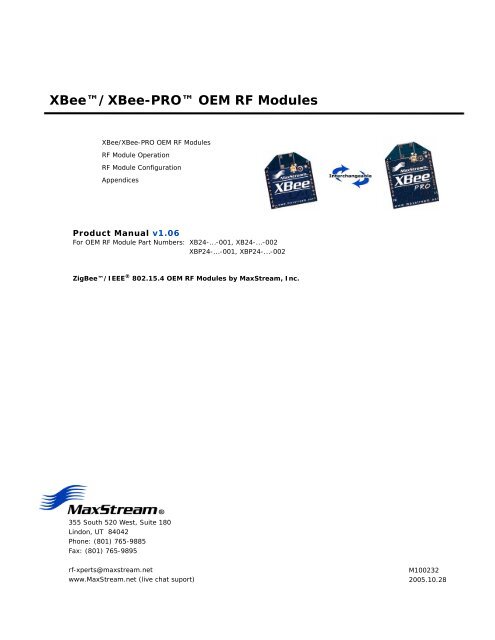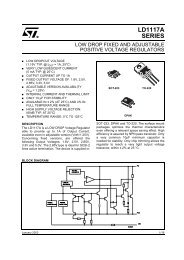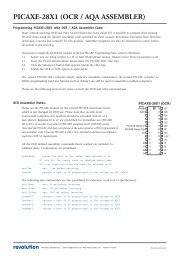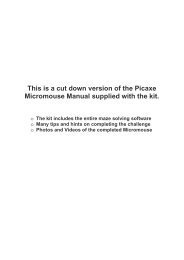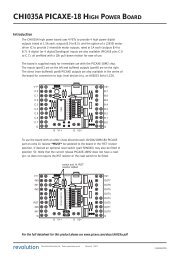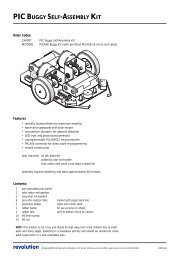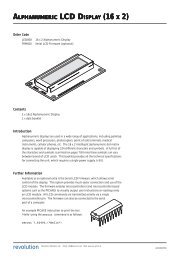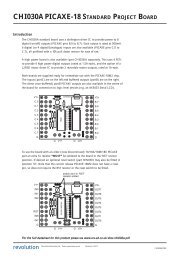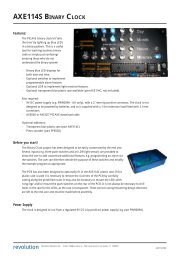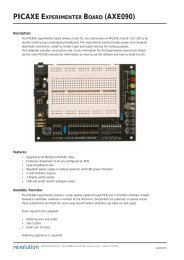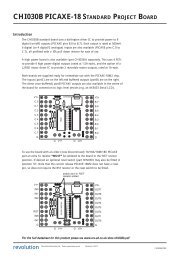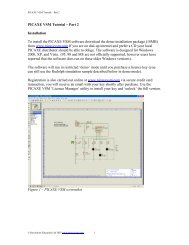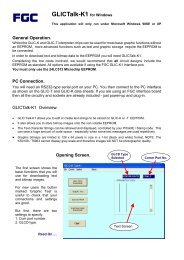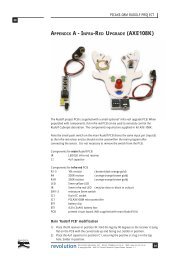XBeeâ¢/XBee-PRO⢠OEM RF Modules - Picaxe
XBeeâ¢/XBee-PRO⢠OEM RF Modules - Picaxe
XBeeâ¢/XBee-PRO⢠OEM RF Modules - Picaxe
Create successful ePaper yourself
Turn your PDF publications into a flip-book with our unique Google optimized e-Paper software.
<strong>XBee</strong>/<strong>XBee</strong>-PRO <strong>OEM</strong> <strong>RF</strong> <strong>Modules</strong><strong>XBee</strong>/<strong>XBee</strong>-PRO <strong>OEM</strong> <strong>RF</strong> <strong>Modules</strong><strong>RF</strong> Module Operation<strong>RF</strong> Module ConfigurationAppendicesProduct Manual v1.06For <strong>OEM</strong> <strong>RF</strong> Module Part Numbers: XB24-...-001, XB24-...-002XBP24-...-001, XBP24-...-002ZigBee/IEEE ® 802.15.4 <strong>OEM</strong> <strong>RF</strong> <strong>Modules</strong> by MaxStream, Inc.355 South 520 West, Suite 180Lindon, UT 84042Phone: (801) 765-9885Fax: (801) 765-9895rf-xperts@maxstream.netwww.MaxStream.net (live chat suport)M1002322005.10.28
<strong>XBee</strong>/<strong>XBee</strong>‐PRO <strong>OEM</strong> <strong>RF</strong> <strong>Modules</strong> ‐ Product Manual v1.06 [2005.10.28]© 2005 MaxStream, Inc. All rights reservedNo part of the contents of this manual may be transmitted or reproduced in anyform or by any means without the written permission of MaxStream, Inc.<strong>XBee</strong> and <strong>XBee</strong>‐PRO are trademarks of MaxStream, Inc.ZigBee is a registered trademark of the ZigBee Alliance.Technical Support: Phone: (801) 765‐9885Live Chat: www.maxstream.netE‐mail: rf‐xperts@maxstream.net© 2005 MaxStream, Inc., Confidential & Proprietary ‐ All Rights Reserved ii
<strong>XBee</strong>/<strong>XBee</strong>‐PRO <strong>OEM</strong> <strong>RF</strong> <strong>Modules</strong> – Product Manual v1.06 [2005.10.28]Contents1. <strong>XBee</strong>/<strong>XBee</strong>-PRO <strong>OEM</strong> <strong>RF</strong> <strong>Modules</strong> 41.1. Key Features 41.1.1. Worldwide Acceptance 41.2. Specifications 51.3. Mechanical Drawings 51.4. Pin Signals 61.5. Electrical Characteristics 62. <strong>RF</strong> Module Operation 72.1. Serial Communications 72.1.1. UART Data Flow 72.1.2. Flow Control 82.2. Modes of Operation 92.2.1. Idle Mode 92.2.2. Transmit & Receive Modes 92.2.3. Sleep Mode 112.2.4. Command Mode 133. <strong>RF</strong> Module Configuration 143.1. Programming the <strong>RF</strong> Module 143.1.1. Programming Examples 143.1.2. Command Reference Tables 153.2. Command Descriptions 16Appendix A: Agency Certifications 23FCC Certification 23<strong>OEM</strong> Labeling Requirements 23FCC Notices 23FCC-Approved Antennas (2.4 GHz) 24European Certification (pending) 25<strong>OEM</strong> Labeling Requirements 25Restrictions 25Declarations of Conformity 25Appendix B: Development Guide 26Development Kit Contents 26Interfacing Options 26RS-232 Interface Board 27Physical Interface 27RS-232 Pin Signals 28Wiring Diagrams 29Adapters 30USB Interface Board 31Physical Interface 31USB Pin Signals 31Appendix C: Additional Information 321-Year Warranty 32Ordering Information 32Contact MaxStream 33© 2005 MaxStream, Inc., Confidential & Proprietary ‐ All Rights Reserved iii
<strong>XBee</strong>/<strong>XBee</strong>‐PRO <strong>OEM</strong> <strong>RF</strong> <strong>Modules</strong> – Product Manual v1.06 [2005.10.28]1. <strong>XBee</strong>/<strong>XBee</strong>‐PRO <strong>OEM</strong> <strong>RF</strong> <strong>Modules</strong>1.1. Key Features<strong>XBee</strong> and <strong>XBee</strong>-PRO <strong>Modules</strong> were engineered to meetZigBee/IEEE 802.15.4 standards and support the uniqueneeds of low-cost, low-power wireless sensor networks.The modules require minimal power and provide reliabledelivery of critical data between devices.The modules operate within the ISM 2.4 GHz frequencyband and are pin-for-pin compatible with each other.High Performance, Low Cost<strong>XBee</strong>• Indoor/Urban: up to 100’ (30 m)• Outdoor line-of-sight: up to 300’ (100 m)• Transmit Power: 1 mW (0 dBm)• Receiver Sensitivity: -92 dBm<strong>XBee</strong>-PRO• Indoor/Urban: up to 300’ (100 m)• Outdoor line-of-sight: up to 1 mile (1500 m)• Transmit Power: 100 mW (20 dBm) EIRP• Receiver Sensitivity: -100 dBm<strong>RF</strong> Data Rate: 250,000 bpsAdvanced Networking & SecurityRetries and AcknowledgementsDSSS (Direct Sequence Spread Spectrum)Each direct sequence channels has over65,000 unique network addresses availablePoint-to-point, point-to-multipointand peer-to-peer topologies supported128-bit Encryption (downloadable firmwareversion coming soon)Self-routing/Self-healing mesh networking(downloadable firmware version coming soon)Low Power<strong>XBee</strong>• TX Current: 45 mA (@3.3 V)• RX Current: 50 mA (@3.3 V)• Power-down Current: < 10 µA<strong>XBee</strong>-PRO• TX Current: 270 mA (@3.3 V)• RX Current: 55 mA (@3.3 V)• Power-down Current: < 10 µAEasy-to-UseNo configuration necessary forout-of box <strong>RF</strong> communicationsFree X-CTU Software(Testing and configuration software)AT Command Mode for simpleconfiguration of module parametersSmall form factorNetwork compatible with otherZigBee/802.15.4 devicesFree & Unlimited Technical Support1.1.1. Worldwide AcceptanceFCC Approval (USA) Refer to Appendix A [p23] for FCC Requirements.Systems that include <strong>XBee</strong>/<strong>XBee</strong>-PRO <strong>Modules</strong> inherit MaxStream’s Certifications.ISM (Industrial, Scientific & Medical) 2.4 GHz frequency bandManufactured under ISO 9001:2000 registered standards<strong>XBee</strong>/<strong>XBee</strong>-PRO <strong>RF</strong> <strong>Modules</strong> are optimized for use in US, Canada, Australia, Israeland Europe (contact MaxStream for complete list of approvals).© 2005 MaxStream, Inc., Confidential & Proprietary ‐ All Rights Reserved 4
<strong>XBee</strong>/<strong>XBee</strong>‐PRO <strong>OEM</strong> <strong>RF</strong> <strong>Modules</strong> – Product Manual v1.06 [2005.10.28]1.2. SpecificationsTable 1‐01.Specifications of the <strong>XBee</strong>/<strong>XBee</strong>‐PRO <strong>OEM</strong> <strong>RF</strong> <strong>Modules</strong>Specification <strong>XBee</strong> <strong>XBee</strong>-PROPerformanceIndoor/Urban Range up to 100 ft. (30 m) Up to 300’ (100 m)Outdoor <strong>RF</strong> line-of-sight Range up to 300 ft. (100 m) Up to 1 mile (1500 m)Transmit Power Output 1mW (0 dBm) 60 mW (18 dBm) conducted, 100 mW (20 dBm) EIRP<strong>RF</strong> Data Rate 250,000 bps 250,000 bpsInterface Data Rate(software selectable)1.3. Mechanical Drawings1200 - 115200 bps(non-standard baud rates also supported)1200 - 115200 bps(non-standard baud rates also supported)Receiver Sensitivity -92 dBm (1% packet error rate) -100 dBm (1% packet error rate)Power RequirementsSupply Voltage 2.8 – 3.4 V 2.8 – 3.4 VTransmit Current (typical) 45 mA (@ 3.3 V) 270 mA (@ 3.3 V)Receive Current (typical) 50 mA (@ 3.3 V) 55 mA (@ 3.3 V)Power-down Current < 10 µA < 10 µAGeneralOperating Frequency ISM 2.4 GHz ISM 2.4 GHzDimensions 0.960” x 1.087” (2.438cm x 2.761cm) 0.960” x 1.297” (2.438cm x 3.294cm)Operating Temperature -40 to 85º C (industrial) -40 to 85º C (industrial)Antenna Options U.FL Connector, Chip Antenna or Whip Antenna U.FL Connector, Chip Antenna or Whip AntennaNetworking & SecuritySupported Network TopologiesPoint-to-Point, Point-to-Multipoint,Peer-to-Peer and Mesh (coming soon)Point-to-Point, Point-to-Multipoint,Peer-to-Peer and Mesh (coming soon)Number of Channels(software selectable)16 Direct Sequence Channels 13 Direct Sequence ChannelsFiltration Options PAN ID, Channel and Source/Destination Addresses PAN ID, Channel and Source/Destination AddressesAgency ApprovalsFCC Part 15.247 OUR-XBEE pendingIndustry Canada (IC) pending pendingEurope pending pendingFigure 1‐01. Mechanical drawings of the <strong>XBee</strong>/<strong>XBee</strong>‐PRO <strong>OEM</strong> <strong>RF</strong> <strong>Modules</strong> (antenna options not shown)<strong>XBee</strong> and <strong>XBee</strong>‐PRO <strong>RF</strong> <strong>Modules</strong> are pin‐for‐pin compatible.© 2005 MaxStream, Inc., Confidential & Proprietary ‐ All Rights Reserved 5
<strong>XBee</strong>/<strong>XBee</strong>‐PRO <strong>OEM</strong> <strong>RF</strong> <strong>Modules</strong> – Product Manual v1.06 [2005.10.28]1.4. Pin SignalsFigure 1‐02. <strong>XBee</strong>/<strong>XBee</strong>‐PRO <strong>RF</strong> Module Pin Number(top sides shown ‐ shields on bottom)Table 1‐02.* Functions not supported at the time of this release.Design Notes:• Minimum connections are: VCC, GND, DOUT and DIN• Signal Direction is specified with respect to the module• Module includes a 50k pull-up resistor attached to RESET• Unused pins should be left disconnected.1.5. Electrical CharacteristicsTable 1‐03.Pin Assignments for the <strong>XBee</strong> and <strong>XBee</strong>‐PRO <strong>Modules</strong>(Low‐asserted signals are distinguished with a horizontal line above signal name.)Pin # Name Direction Description1 VCC - Power supply2 DOUT Output UART Data Out3 DIN / CONFIG Input UART Data In4 CD* / DOUT_EN* / DO8* Output Carrier Detect, TX_enable or Digital Output 85 RESET Input Module Reset6 PWM0 / RSSI Output PWM Output 0 or RX Signal Strength Indicator7 [reserved] - Do not connect8 [reserved] - Do not connect9 DTR / SLEEP_RQ / DI8 Input Pin Sleep Control Line or Digital Input 810 GND - Ground11 <strong>RF</strong>_TX* / AD4* / DIO4* Either Transmission Indicator, Analog Input 4 or Digital I/O 412 CTS* / DIO7* Either Clear-to-Send Flow Control or Digital I/O 713 ON / SLEEP Output Module Status Indicator14 VREF* Input Voltage Reference for A/D Inputs15 Associate / AD5* / DIO5* Either Associated Indicator, Analog Input 5 or Digital I/O 516 RTS* / AD6* / DIO6* Either Request-to-Send Flow Control, Analog Input 6 or Digital I/O 617 COORD_SEL* / AD3* / DIO3* Either Analog Input 3, Digital I/O 3 or Coordinator Select18 AD2* / DIO2* Either Analog Input 2 or Digital I/O 219 AD1* / DIO1* Either Analog Input 1 or Digital I/O 120 AD0* / DIO0* Either Analog Input 0 or Digital I/O 0DC Characteristics of the <strong>XBee</strong> & <strong>XBee</strong>‐PRO (VCC = 2.8 ‐ 3.4 VDC)Symbol Parameter Condition Min Typical Max UnitsV IL Input Low Voltage All Digital Inputs - - 0.35 * VCC VV IH Input High Voltage All Digital Inputs 0.7 * VCC - - VV OL Output Low Voltage I OL = 2 mA, VCC >= 2.7 V - - 0.5 VV OH Output High Voltage I OH = -2 mA, VCC >= 2.7 V VCC - 0.5 - - VII IN Input Leakage Current V IN = VCC or GND, all inputs, per pin - 0.025 1 uAII OZ High Impedance Leakage Current V IN = VCC or GND, all I/O High-Z, per pin - 0.025 1 uATX Transmit Current VCC = 3.3 V -RX Receive Current VCC = 3.3 V -45(<strong>XBee</strong>)50(<strong>XBee</strong>)270(PRO)55(PRO)- mA- mAPWR-DWN Power-down Current SM parameter = 1 - < 10 - uA© 2005 MaxStream, Inc., Confidential & Proprietary ‐ All Rights Reserved 6
<strong>XBee</strong>/<strong>XBee</strong>‐PRO <strong>OEM</strong> <strong>RF</strong> <strong>Modules</strong> – Product Manual v1.06 [2005.10.28]2. <strong>RF</strong> Module Operation2.1. Serial CommunicationsThe <strong>XBee</strong>/<strong>XBee</strong>-PRO <strong>OEM</strong> <strong>RF</strong> <strong>Modules</strong> interface to a host device through a logic-level asynchronousserial port. Through its serial port, the module can communicate with any logic and voltagecompatible UART; or through a level translator to any serial device (For example: RS-232/485/422 or USB interface board).2.1.1. UART Data FlowDevices that have a UART interface can connect directly to the pins of the <strong>RF</strong> module as shown inthe figure below.Figure 2‐01. Figure 2‐01.System Data Flow Diagram in a UART‐interfaced environment(Low‐asserted signals distinguished with horizontal line over signal name.)Serial DataData enters the module UART through the DI pin (pin 3) as an asynchronous serial signal. The signalshould idle high when no data is being transmitted.Each data byte consists of a start bit (low), 8 data bits (least significant bit first) and a stop bit(high). The following figure illustrates the serial bit pattern of data passing through the module.Figure 2‐02. UART data packet 0x1F (decimal number ʺ31ʺ) as transmitted through the <strong>RF</strong> moduleExample Data Format is 8‐N‐1 (bits ‐ parity ‐ # of stop bits)The module UART performs tasks, such as timing and parity checking, that are needed for datacommunications. Serial communications depend on the two UARTs to be configured with compatiblesettings (baud rate, parity, start bits, stop bits, data bits)Both the module and host (PC) settings can be viewed and adjusted using MaxStream's proprietaryX-CTU Software. Use the "PC Settings" tab to configure host settings. Use the "Terminal" or"<strong>RF</strong> Module Configuration" tab to configure the module settings.NOTE: Failure to enter AT Command Mode is most commonly due to baud rate mismatch. Ensure the‘Baud’ setting on the “PC Settings” tab matches the interface data rate of the <strong>RF</strong> module (by default, BDparameter = 3 (which is associated to 9600 bps)).© 2005 MaxStream, Inc., Confidential & Proprietary ‐ All Rights Reserved 7
<strong>XBee</strong>/<strong>XBee</strong>‐PRO <strong>OEM</strong> <strong>RF</strong> <strong>Modules</strong> – Product Manual v1.06 [2005.10.28]2.1.2. Flow ControlFigure 2‐03. Internal Data Flow DiagramDI (Data In) BufferWhen serial data enters the <strong>RF</strong> module through the DI pin (pin 3), the data is stored in the DIBuffer until it can be processed.Hardware Flow Control (CTS). When the DI buffer is 17 bytes away from being full; by default,the module de-asserts CTS (high) to signal to the host device to stop sending data [refer to D7(DIO7 Configuration) parameter]. CTS is re-asserted after the DI Buffer has 34 bytes of memoryavailable.How to eliminate the need for flow control:1. Send messages that are smaller than the DI buffer size.2. Interface at a lower baud rate [BD (Interface Data Rate) parameter] than the throughputdata rate.Case in which the DI Buffer may become full and possibly overflow:If the module is receiving a continuous stream of <strong>RF</strong> data, any serial data that arrives on the DIpin is placed in the DI Buffer. The data in the DI buffer will be transmitted over-the-air when themodule is no longer receiving <strong>RF</strong> data in the network.NOTE: CTS hardware flow control is not supported in this release (v1.06). Contact MaxStream supportto download firmware that supports this function.DO (Data Out) BufferWhen <strong>RF</strong> data is received, the data enters the DO buffer and is sent out the serial port to a hostdevice. Once the DO Buffer reaches capacity, any additional incoming <strong>RF</strong> data is lost.Hardware Flow Control (RTS). If RTS is enabled for flow control (D6 (DIO6 Configuration)Parameter = 1), data will not be sent out the DO Buffer as long as RTS (pin 16) is de-asserted.Two cases in which the DO Buffer may become full and possibly overflow:1. If the <strong>RF</strong> data rate is set higher than the interface data rate of the module, the module willreceive data from the transmitting module faster than it can send the data to the host.2. If the host does not allow the module to transmit data out from the DO buffer because ofbeing held off by hardware or software flow control.NOTE: RTS hardware flow control is not supported in this release (v1.06). Contact MaxStream supportto download firmware that supports this function.© 2005 MaxStream, Inc., Confidential & Proprietary ‐ All Rights Reserved 8
<strong>XBee</strong>/<strong>XBee</strong>‐PRO <strong>OEM</strong> <strong>RF</strong> <strong>Modules</strong> – Product Manual v1.06 [2005.10.28]2.2. Modes of Operation<strong>XBee</strong>/<strong>XBee</strong>-PRO <strong>RF</strong> <strong>Modules</strong> operate in five modes.Figure 2‐04. <strong>XBee</strong>/<strong>XBee</strong>‐PRO <strong>RF</strong> ModuleModes of Operation2.2.1. Idle ModeWhen not receiving or transmitting data, the <strong>RF</strong> module is in Idle Mode. The <strong>RF</strong> module shifts intothe other modes of operation under the following conditions:• Transmit Mode: Serial data is received in the DI Buffer• Receive Mode: Valid <strong>RF</strong> data is received through the antenna• Sleep Mode: Sleep Mode condition is met• Command Mode: Command Mode Sequence is issued2.2.2. Transmit & Receive ModesAddressingWhen communication occurs between two networked devices, each data packet contains a and a field. The <strong>XBee</strong>/<strong>XBee</strong>-PRO <strong>RF</strong> Module conformsto the 802.15.4 specification and supports both short 16-bit addresses and long 64-bit addresses.A unique 64-bit IEEE source address is assigned at the factory and can be read with the SL (SerialNumber Low) and SH (Serial Number High) parameters. Short addressing must be configuredmanually. An <strong>RF</strong> module will use its unique 64-bit address as its Source Address if its MY value is“0xFFFF” or “0xFFFE”.To send a packet to a specific <strong>RF</strong> module using 64-bit addressing, set the Destination Address (DL+ DH) to match the Source Address (SL + SH) of the intended destination <strong>RF</strong> module. To send apacket to a specific <strong>RF</strong> module using 16-bit addressing, set the DL (Destination Address Low)parameter to the MY (Source Address) parameter and set the DH (Destination Address High)parameter to “0”.Unicast ModeUnicast Mode enables acknowledged communications. While in this mode, receiving modules sendan ACK (acknowledgement) of <strong>RF</strong> packet reception to the transmitter. If the transmitting moduledoes not receive the ACK, the transmitter will re-send the packet up to three times until the ACK isreceived.Unicast Mode is the only mode that supports retries.Short 16-bit addresses. The module can be configured to use short 16-bit addresses as theSource Address by setting (MY < 0xFFFE). Setting the DH parameter (DH = 0) will configure theDestination Address to be a short 16-bit address (if DL < 0xFFFE). For two modules to communicateusing short addressing, the Destination Address of the transmitter module must match theMY parameter of the receiver.© 2005 MaxStream, Inc., Confidential & Proprietary ‐ All Rights Reserved 9
<strong>XBee</strong>/<strong>XBee</strong>‐PRO <strong>OEM</strong> <strong>RF</strong> <strong>Modules</strong> – Product Manual v1.06 [2005.10.28]The following table shows a sample network configuration that would enable Unicast Mode communicationsusing 16-bit short addresses.Table 2‐01.Sample Unicast Configuration (using 16‐bit addressing)Parameter <strong>RF</strong> Module 1 <strong>RF</strong> Module 2MY (Source Address) 0x01 0x02DH (Destination Address High) 0 0DL (Destination Address Low) 0x02 0x01Long 64-bit addresses. The <strong>RF</strong> module’s serial number (SL parameter concatenated to the SHparameter) can be used as a 64-bit source address when the MY (16-bit Source Address) parameteris disabled. When the MY parameter is disabled (set MY = 0xFFFF or 0xFFFE), the module’ssource address is set to the 64-bit IEEE address stored in the SH and SL parameters.When an End Device associates to a Coordinator, its MY parameter is set to 0xFFFE to enable 64-bit addressing. The 64-bit address of the module is stored as SH and SL parameters. To send apacket to a specific module, the Destination Address (DL + DH) on one module must match theSource Address (SL + SH) of the other.Broadcast ModeAny <strong>RF</strong> module will accept a packet that contains a broadcast address. When configured to operatein Broadcast Mode, receiving modules do not send ACKs (Acknowledgements) and transmitting <strong>RF</strong>modules do not automatically re-send packets as is the case in Unicast Mode.To send a broadcast packet to all modules regardless of 16-bit or 64-bit addressing, set destinationaddresses of all the modules as shown below.Sample Configuration (All modules in the network):• DL (Destination Low Address) = 0x0000FFFF• DH (Destination High Address) = 0x00000000NOTE: When programming the module, parameters are entered in hexadecimal notation (withoutthe “0x” prefix). Leading zeros may be omitted.© 2005 MaxStream, Inc., Confidential & Proprietary ‐ All Rights Reserved 10
<strong>XBee</strong>/<strong>XBee</strong>‐PRO <strong>OEM</strong> <strong>RF</strong> <strong>Modules</strong> – Product Manual v1.06 [2005.10.28]2.2.3. Sleep ModeSleep Modes enable the <strong>RF</strong> module to enter states of low-power consumption when not in use. Inorder to enter Sleep Mode, one of the following conditions must be met (in addition to the modulehaving a non-zero SM parameter value):• Sleep_RQ (pin 9) is asserted.• The module is idle (no data transmission or reception) for the amount of time defined by theST (Time before Sleep) parameter. [NOTE: ST is only active when SM = 4-5.]Table 2‐02.Sleep Mode ConfigurationsSleep ModeSettingPin Hibernate(SM = 1)Pin Doze(SM = 2)Cyclic Sleep(SM = 4 - 5)Transition intoSleep ModeAssert (high) Sleep_RQ(pin 9)Assert (high) Sleep_RQ(pin 9Automatic transition toSleep Mode as defined bythe SM (Sleep Mode) andST (Time before Sleep)parameters.Transition out ofSleep Mode (wake)De-assert (low) Sleep_RQDe-assert (low) Sleep_RQTransition occurs after thecyclic sleep time intervalelapses. The time intervalis defined by the SP (CyclicSleep Period) parameter.CharacteristicsPin/Host-controlled /NonBeacon systemsonly / Lowest PowerPin/Host-controlled /NonBeacon systemsonly / Fastest Wakeup<strong>RF</strong> Module wakes inpre-determined timeintervals to detect if<strong>RF</strong> data is present /When SM = 5,NonBeacon systemsonlyRelatedCommands(SM)PowerConsumption< 10 µA (@3.0VCC)(SM) < 50 µA(SM), SP, ST< 50 µAwhen sleepingThe SM command is central to setting Sleep Mode configurations. By default, Sleep Modes are disabled(SM = 0) and the module remains in Idle/Receive Mode. When in this state, the module isconstantly ready to respond to serial or <strong>RF</strong> activity.Pin/Host-controlled Sleep ModesPin Hibernate (SM = 1)• Pin/Host-controlled• Typical power-down current: < 10 µA (@3.0 VCC)• Wake-up time: 13.2 msecPin Hibernate Mode minimizes quiescent power (power consumed when in a state of rest or inactivity).This mode is voltage level-activated; when Sleep_RQ is asserted, the module will finish anytransmit, receive or association activities, enter Idle Mode and then enter a state of sleep. Themodule will not respond to either serial or <strong>RF</strong> activity while in pin sleep.To wake a sleeping module operating in Pin Hibernate Mode, de-assert Sleep_RQ (pin 9). Themodule will wake when Sleep_RQ is de-asserted and is ready to transmit or receive when the CTSline is low.Pin Doze (SM = 2)• Pin/Host-controlled• Typical power-down current: < 50 µA• Wake-up time: 2 msecPin Doze Mode functions as does Pin Hibernate Mode; however, Pin Doze features faster wake-uptime and higher power consumption.© 2005 MaxStream, Inc., Confidential & Proprietary ‐ All Rights Reserved 11
<strong>XBee</strong>/<strong>XBee</strong>‐PRO <strong>OEM</strong> <strong>RF</strong> <strong>Modules</strong> – Product Manual v1.06 [2005.10.28]Cyclic Sleep ModesCyclic Sleep Remote (SM = 4)• Typical Power-down Current: < 50 µA (when asleep)• Wake-up time: 2 msecThe Cyclic Sleep Modes allow modules to periodically check for <strong>RF</strong> data. When the SM parameter isset to ‘4’, the module is configured to sleep, then wakes once a cycle to check for data from amodule configured as a Cyclic Sleep Coordinator (SM = 6). The Cyclic Sleep Remote sends a pollrequest to the coordinator at a specific interval set by the SP (Cyclic Sleep Period) parameter. Thecoordinator will transmit any queued data addressed to that specific remote upon receiving thepoll request. If no data is queued for the remote, the coordinator will not transmit and the remotewill return to sleep for another cycle. If queued data is transmitted back to the remote, it will stayawake to allow for back and forth communication until the ST (Time before Sleep) timer expires.Also note that CTS will go low each time the remote wakes, allowing for communication initiatedby the remote host if desired.Cyclic Sleep Remote with Pin Wake-up (SM = 5)Use this mode to wake a sleeping remote module through either the <strong>RF</strong> interface or by the deassertionof Sleep_RQ for event-driven communications. The cyclic sleep mode works as describedabove (Cyclic Sleep Remote) with the addition of a pin-controlled wake-up at the remote module.The module will wake quickly when a low is detected and set CTS low as soon as it is ready totransmit or receive. Any activity will reset the ST (Time before Sleep) timer so the module will goback to sleep only after Sleep_RQ is asserted and there is no activity for the duration of the timer.© 2005 MaxStream, Inc., Confidential & Proprietary ‐ All Rights Reserved 12
<strong>XBee</strong>/<strong>XBee</strong>‐PRO <strong>OEM</strong> <strong>RF</strong> <strong>Modules</strong> – Product Manual v1.06 [2005.10.28]2.2.4. Command ModeTo modify or read <strong>RF</strong> Module parameters, the module must first enter into Command Mode - astate in which incoming characters are interpreted as commands. Two command modes are supported:AT Command Mode and ATI Command Mode.A robust set of AT Commands is available for programming and customizing the module.AT Command ModeTo Enter AT Command Mode:Send the 3-character command sequence “+++” and observe guard times before and after thecommand characters. [Refer to the “Default AT Command Mode Sequence” below.]Default AT Command Mode Sequence (for transition to Command Mode):• No characters sent for one second [GT (Guard Times) parameter = 0x3E8]• Input three plus characters (“+++”) within one second [CC (Command Sequence Character)parameter = 0x2B.]• No characters sent for one second [GT (Guard Times) parameter = 0x3E8]All of the parameter values in the sequence can be modified to reflect user preferences.To Send AT Commands:Send AT commands and parameters using the syntax shown below.Figure 2‐05. Syntax for sending AT CommandsTo read a parameter value stored in the <strong>RF</strong> module’s register, leave the parameter field blank.The preceding example would change the <strong>RF</strong> module Destination Address (Low) to “0x1F”. Tostore the new value to non-volatile (long term) memory, subsequently send the WR (Write) command.For modified parameter values to persist in the module’s registry, changes must be saved to nonvolatilememory using the WR (Write) Command. Otherwise, parameters are restored to previouslysaved values after the module is powered off and then on again (or re-booted).System Response. When a command is sent to the <strong>RF</strong> module, the module will parse and executethe command. Upon successful execution of a command, the module returns an “OK” message.If execution of a command results in an error, the module returns an “ERROR” message.To Exit AT Command Mode:1. Send ATCN (Exit Command Mode) Command.[OR]2. If no valid AT Commands are received within the time specified by CT (Command ModeTimeout) Command, the <strong>RF</strong> module automatically returns to Idle Mode.For an example of programming the <strong>RF</strong> module using AT Commands and descriptions of each configurableparameter, refer to the "<strong>RF</strong> Module Configuration" chapter [p14].© 2005 MaxStream, Inc., Confidential & Proprietary ‐ All Rights Reserved 13
<strong>XBee</strong>/<strong>XBee</strong>‐PRO <strong>OEM</strong> <strong>RF</strong> <strong>Modules</strong> – Product Manual v1.06 [2005.10.28]3.2. Command DescriptionsCommand descriptions in this section are listed alphabetically. Command categories are designatedwithin "< >" symbols that follow each command title. <strong>XBee</strong>-PRO <strong>RF</strong> modules expect parametervalues in hexadecimal (designated by the "0x" prefix).BD (Interface Data Rate) Command The BD command is used toset and read the serial interface data rate (baudrate) used between the <strong>RF</strong> module and host. Thisparameter determines the rate at which serialdata is sent to the <strong>RF</strong> module from the host. Modifiedinterface data rates do not take effect untilthe CN (Exit AT Command Mode) command isissued and the system returns the 'OK' response.When parameters 0-7 are sent to the <strong>RF</strong> module,the respective interface data rates are used (asshown in the table on the right).The <strong>RF</strong> data rate is not affected by the BD parameter.If the interface data rate is set higher thanthe <strong>RF</strong> data rate, a flow control configuration mayneed to be implemented.AT Command: ATBDParameter Range: 0 - 7 (standard rates)Parameter Configuration (bps)0 12001 24002 48003 96004 192005 384006 576007 115200Default Parameter Value:3Non-standard Interface Data Rates:When parameter values outside the range of standard baud rates are sent, the closest interfacedata rate represented by the number is stored in the BD register. For example, a rate of 19200bps can be set by sending the following command line "ATBD4B00". NOTE: When using Max-Stream’s X-CTU Software, non-standard interface data rates can only be set and read using the X-CTU ‘Terminal’ tab. Non-standard rates are not accessible through the ‘Modem Configuration’ tab.When the BD command is sent with a non-standard interface data rate, the UART will adjust toaccommodate the requested interface rate. In most cases, the clock resolution will cause thestored BD parameter to vary from the parameter that was sent (refer to the table below). Readingthe BD command (send "ATBD" command without an associated parameter value) will return thevalue that was actually stored to the BD register.Table 3‐02.Parameters Sent Versus Parameters StoredBD Parameter Sent (HEX) Interface Data Rate (bps) BD Parameter Stored (HEX)0 1200 04 19,200 47 115,200 712C 300 12B1C200 115,200 1B207CC (Command Sequence Character) Command The CC commandis used to set and read the ASCII character usedbetween guard times of the AT Command ModeSequence (GT + CC + GT). This sequence entersthe <strong>RF</strong> module into AT Command Mode so thatdata entering the modem from the host is recognizedas commands instead of payload.AT Command: ATCCParameter Range: 0 - 0xFFDefault Parameter Value: 0x2B (ASCII “+”)Related Commands: GT (Guard Times)Refer to the Command Mode section [p13] for more information regarding the AT Command ModeSequence.© 2005 MaxStream, Inc., Confidential & Proprietary ‐ All Rights Reserved 16
<strong>XBee</strong>/<strong>XBee</strong>‐PRO <strong>OEM</strong> <strong>RF</strong> <strong>Modules</strong> – Product Manual v1.06 [2005.10.28]CH (Channel) Command The CH command isused to set and read the channel on which <strong>RF</strong>connections are made between <strong>RF</strong> modules. Thechannel is one of three filtration layers availableto the <strong>RF</strong> module. The other layers are the PANID (ID command) and destination addresses (DL& DH commands).In order for <strong>RF</strong> modules to communicate witheach other, the <strong>RF</strong> modules must share the same channel number. Different channels can be usedto prevent <strong>RF</strong> modules in one network from listening to transmissions of another.The <strong>RF</strong> module uses channel numbers of the 802.15.4 standard.Center Frequency = 2.405 + (CH - 11d) * 5 MHzRefer to the “Addressing” section [p9] for more information.CN (Exit AT Command Mode) CommandAT Command: ATCHParameter Range: 0x0B - 0x1A (<strong>XBee</strong>)0x0C - 0x18 (<strong>XBee</strong>-PRO)Default Parameter Value: 0x0C (12 decimal)Related Commands: ID (PAN ID), DL(Destination Address Low, DH (DestinationAddress High)(d = decimal) The CN commandis used to explicitly exit the <strong>RF</strong> module from ATCommand Mode.AT Command: ATCNCT (Command Mode Timeout) Command The CT commandis used to set and read the amount of inactivetime that elapses before the <strong>RF</strong> module automaticallyexits from AT Command Mode and returnsto Idle Mode.Use the CN (Exit AT Command Mode) commandto exit AT Command Mode manually.AT Command: ATCTParameter Range: 2 - 0xFFFF[x 100 milliseconds]Default Parameter Value: 0x64 (100 decimal,which equals 10 decimal seconds)Number of bytes returned: 2Related Command: CN (Exit AT CommandMode)DB (Received Signal Strength) Command DB parameter is used to read theAT Command: ATDBreceived signal strength (in dBm) of the last <strong>RF</strong>Parameter Range: 0 - 0x64 [read-only]packet received. Reported values are accuratebetween -40 dBm and the <strong>RF</strong> module's receiver sensitivity.Absolute values are reported. For example: 0x58 = -88 dBm (decimal). If no packets have beenreceived (since last reset, power cycle or sleep event), “0” will be reported.DH (Destination Address High) Command The DH command isused to set and read the upper 32 bits of the <strong>RF</strong>module's 64-bit destination address. When combinedwith the DL (Destination Address Low)parameter, it defines the destination addressused for transmission.An <strong>RF</strong> module will only communicate with other<strong>RF</strong> modules having the same channel (CH parameter),PAN ID (ID parameter) and destination address(DH + DL parameters).AT Command: ATDHParameter Range: 0 - 0xFFFFFFFFDefault Parameter Value: 0Related Commands: DL (Destination AddressLow), CH (Channel), ID (PAN VID), MY (SourceAddress)To transmit using a 16-bit address, set the DH parameter to zero and the DL parameter less than0xFFFF. 0x000000000000FFFF (DL concatenated to DH) is the broadcast address for the PAN.Refer to the “Addressing” section [p9] for more information.© 2005 MaxStream, Inc., Confidential & Proprietary ‐ All Rights Reserved 17
<strong>XBee</strong>/<strong>XBee</strong>‐PRO <strong>OEM</strong> <strong>RF</strong> <strong>Modules</strong> – Product Manual v1.06 [2005.10.28]DL (Destination Address Low) Command The DL command isused to set and read the lower 32 bits of the <strong>RF</strong>module's 64-bit destination address. When combinedwith the DH (Destination Address High)parameter, it defines the destination addressused for transmission.An <strong>RF</strong> module will only communicate with other<strong>RF</strong> modules having the same channel (CH parameter),PAN ID (ID parameter) and destination address (DH + DL parameters).To transmit using a 16-bit address, set the DH parameter to zero and the DL parameter less than0xFFFF. 0x000000000000FFFF (DL concatenated to DH) is the broadcast address for the PAN.Refer to the “Addressing” section [p9] for more information.GT (Guard Times) Command GT Command isused to set the DI (data in from host) time-ofsilencethat surrounds the AT command sequencecharacter (CC Command) of the AT CommandMode sequence (GT + CC + GT).The DI time-of-silence is used to prevent inadvertententrance into AT Command Mode.Refer to the Command Mode section [p13] formore information regarding the AT Command Mode Sequence.ID (Pan ID) CommandAT Command: ATDLParameter Range: 0 - 0xFFFFFFFFDefault Parameter Value: 0Related Commands: DH (Destination AddressHigh), CH (Channel), ID (PAN VID), MY (SourceAddress)AT Command: ATGTParameter Range: 2 - 0xFFFF[x 1 millisecond]Default Parameter Value: 0x3E8(1000 decimal)Related Command: CC (Command SequenceCharacter) The ID command isused to set and read the PAN (Personal Area Network)ID of the <strong>RF</strong> module. Only <strong>RF</strong> modules withmatching PAN IDs can communicate with eachother. <strong>RF</strong> modems with non-matching PAN IDswill not receive unintended data transmission.AT Command: ATIDParameter Range: 0 - 0xFFFFDefault Parameter Value:0x3332(13106 decimal)Setting the ID parameter to 0xFFFF indicates a global message for all PANs.Refer to the “Addressing” section [p9] for more information.MY (16-bit Source Address) Command The MY command isused to set and read the 16-bit source address ofthe <strong>RF</strong> module.By setting MY to 0xFFFF, the reception of <strong>RF</strong>packets having a 16-bit address is disabled. The64-bit address is the module serial number and isalways enabled.Refer to the “Addressing” section [p9] for more information.AT Command: ATMYParameter Range: 0 - 0xFFFFDefault Parameter Value: 0Related Commands: DH (Destination AddressHigh), DL (Destination Address Low), CH(Channel), ID (PAN ID)© 2005 MaxStream, Inc., Confidential & Proprietary ‐ All Rights Reserved 18
<strong>XBee</strong>/<strong>XBee</strong>‐PRO <strong>OEM</strong> <strong>RF</strong> <strong>Modules</strong> – Product Manual v1.06 [2005.10.28]P0 (PWM0 Configuration) Command The P0 command is used to selectand read the function for PWM0 (Pulse WidthModulation output 0 - pin 6).Note: The second character in the command is azero (“0”), not the letter “O”.AT Command: ATP0Parameter Range: 0 - 1Parameter Configuration0 Disabled1 RSSI PWM0 enabledDefault Parameter Value: 1PL (Power Level) Command The PL command is used toselect and read the power level at which the <strong>RF</strong>module transmits conducted power.AT Command: ATPLParameter Range: 0 - 4Parameter <strong>XBee</strong> <strong>XBee</strong>-Pro0 -10 dBm 10 dBm1 -6 dBm 12 dBm2 -4 dBm 14 dBm3 -2 dBm 16 dBm4 0 dBm 18 dBmDefault Parameter Value: 4RE (Restore Defaults) Command The RE command is used to restoreAT Command: ATREall configurable parameters to their factorydefault settings. The RE command does not writerestored values to non-volatile (persistent) memory. Issue the WR (Write) command subsequentto issuing the RE command to save restored parameter values to non-volatile memory.RN (Random Delay Slots) Command The RN command isused to set and read the minimum value of theback-off exponent in the CSMA-CA algorithm. TheCSMA-CA algorithm was engineered for collisionavoidance (random delays are inserted to preventdata loss caused by data collisions).AT Command: ATRNParameter Range: 0 - 3 [exponent]Default Parameter Value: 0If RN = 0, collision avoidance is disabled during the first iteration of the algorithm (802.15.4 -macMinBE).CSMA-CA stands for "Carrier Sense Multiple Access - Collision Avoidance". Unlike CSMA-CD (reactsto network transmissions after collisions have been detected), CSMA-CA acts to prevent data collisionsbefore they occur. As soon as a modem receives a packet that is to be transmitted, it checksif the channel is clear (no other modem is transmitting). If the channel is clear, the packet is sentover-the-air. If the channel is not clear, the <strong>RF</strong> module waits for a randomly selected period oftime, then checks again to see if the channel is clear. After a time, the process ends and the datais lost.© 2005 MaxStream, Inc., Confidential & Proprietary ‐ All Rights Reserved 19
<strong>XBee</strong>/<strong>XBee</strong>‐PRO <strong>OEM</strong> <strong>RF</strong> <strong>Modules</strong> – Product Manual v1.06 [2005.10.28]RO (Packetization Timeout) Command RO command is used to setand read the number of character times of intercharacterdelay required before transmission.<strong>RF</strong> transmission commences when data isdetected in the DI (data in from host) buffer andRO character times of silence are detected on theUART receive lines (after receiving at least 1 byte).AT Command: ATROParameter Range: 0 - 0xFF[x character times]Default Parameter Value: 3<strong>RF</strong> transmission will also commence after 100 bytes (maximum packet size) are received in the DIbuffer.Set the RO parameter to '0' to transmit characters as they arrive instead of buffering them intoone <strong>RF</strong> packet.RP (RSSI PWM Timer) Command The RP command is used toenable PWM (Pulse Width Modulation) output onthe <strong>RF</strong> module. The output is calibrated to showthe level a received <strong>RF</strong> signal is above the sensitivitylevel of the <strong>RF</strong> module. The PWM pulsesvary from zero to 95 percent. Zero to twenty-ninepercent means the received <strong>RF</strong> signal is at or below the published sensitivity level of the <strong>RF</strong> module.The following table shows levels above sensitivity and PWM values.The total period of the PWM output is 8.32 ms. Because there are 40 steps in the PWM output, theminimum step size is 0.208 ms.Table 3‐03.PWM PercentagesdB above SensitivityPWM percentage*(high period / total period)10 46.0%20 63.0%30 80.1%AT Command: ATRPParameter Range: 0 - 0xFF[x 100 milliseconds]Default Parameter Value: 0x28 (40 decimal)* PWM% = (295 + (17.5 * dBm above sensitivity)) / 10.24A non-zero value defines the time that the PWM output will be active with the RSSI value of thelast received <strong>RF</strong> packet. After the set time when no <strong>RF</strong> packets are received, the PWM output willbe set low (0 percent PWM) until another <strong>RF</strong> packet is received. The PWM output will also be setlow at power-up until the first <strong>RF</strong> packet is received. A parameter value of 0xFF permanentlyenables the PWM output and it will always reflect the value of the last received <strong>RF</strong> packet.SH (Serial Number High) Command The SH command is used to readthe high 32 bits of the <strong>RF</strong> module's unique IEEE64-bit address.The <strong>RF</strong> module serial number is set at the factoryand is read-only.AT Command: ATSHParameter Range: 0 - 0xFFFFFFFF [read-only]Related Commands: SL (Serial Number Low),MY (Source Address)SL (Serial Number Low) Command The SL command is used to readthe low 32 bits of the <strong>RF</strong> module's unique IEEE64-bit address.The <strong>RF</strong> module serial number is set at the factoryand is read-only.AT Command: ATSLParameter Range: 0 - 0xFFFFFFFF [read-only]Related Commands: SH (Serial Number High),MY (Source Address)© 2005 MaxStream, Inc., Confidential & Proprietary ‐ All Rights Reserved 20
<strong>XBee</strong>/<strong>XBee</strong>‐PRO <strong>OEM</strong> <strong>RF</strong> <strong>Modules</strong> – Product Manual v1.06 [2005.10.28]SM (Sleep Mode) Command The SM command isused to set and read Sleep Mode settings. Bydefault, Sleep Modes are disabled (SM = 0) andthe <strong>RF</strong> module remains in Idle/Receive Mode.When in this state, the <strong>RF</strong> module is constantlyready to respond to either serial or <strong>RF</strong> activity.SM command options vary according to the networkingsystem type. By default, the module isconfigured to operate in a NonBeacon system.AT Command: ATSMParameter Range: 0 - 5Parameter Configuration0 Disabled1 Pin Hibernate2 Pin Doze3 (reserved)4 Cyclic Sleep RemoteCyclic Sleep Remote5(with Pin Wake-up)Default Parameter Value: 0Related Commands: SP (Cyclic Sleep Period),ST (Time before Sleep)SP (Cyclic Sleep Period) Command The SP command isused to set and read the duration of time in whicha remote <strong>RF</strong> module sleeps. After the cyclic sleepperiod is over, the <strong>RF</strong> module wakes and checksfor data. If data is not present, the <strong>RF</strong> modulegoes back to sleep. The maximum sleep period is268 seconds (SP = 0x68B0).AT Command: ATSPParameter Range: 1 - 0x68B0[x 10 milliseconds]Default Parameter Value: 0x64 (100d)Related Commands: SM (Sleep Mode), ST(Time before Sleep)The SP parameter is only valid if the <strong>RF</strong> module isconfigured to operate in Cyclic Sleep (SM = 4-6).ST (Time before Sleep) Command The ST command isused to set and read the period of time that the<strong>RF</strong> module remains inactive (no transmitting orreceiving) before entering into Sleep Mode.For example, if the ST parameter is set to itsdefault value of 0x1388 (5000 decimal), the <strong>RF</strong>module will enter into Sleep mode after 5 secondsof inactivity. This command can only be used ifCyclic Sleep settings have been selected using SM(Sleep Mode) Command (SM = 4-6).AT Command: ATSTParameter Range: 1 - 0xFFFF[x 1 millisecond]Default Parameter Value:0x1388(5000 decimal)Related Commands: SM (Sleep Mode),SP (Cyclic Sleep Period)NOTE: The GT parameter value must always be less than the ST value. (If GT > ST, the configurationwill render the module unable to enter into command mode.) If the ST parameter is modified, alsomodify the GT parameter accordingly.© 2005 MaxStream, Inc., Confidential & Proprietary ‐ All Rights Reserved 21
<strong>XBee</strong>/<strong>XBee</strong>‐PRO <strong>OEM</strong> <strong>RF</strong> <strong>Modules</strong> – Product Manual v1.06 [2005.10.28]VR (Firmware Version) Command The VR command is used to readwhich firmware version is stored in the <strong>RF</strong> module.AT Command: ATVRParameter Range: 0 - 0xFFFF [read only]WR (Write) Command The WR command is used to writeAT Command: ATWRconfigurable parameters to the <strong>RF</strong> module's nonvolatilememory (Parameter values remain in <strong>RF</strong>module's memory until overwritten by subsequent use of the WR Command).If changes are made without writing them to non-volatile memory, the <strong>RF</strong> module reverts back topreviously saved parameters the next time the <strong>RF</strong> module is powered-on.NOTE: Once the WR command is sent to the <strong>RF</strong> module, no additional characters should be sent untilafter the “OK/r” response is received.© 2005 MaxStream, Inc., Confidential & Proprietary ‐ All Rights Reserved 22
<strong>XBee</strong>/<strong>XBee</strong>‐PRO <strong>OEM</strong> <strong>RF</strong> <strong>Modules</strong> – Product Manual v1.06 [2005.10.28]Appendix A: Agency CertificationsFCC CertificationThe <strong>XBee</strong>/<strong>XBee</strong>-PRO <strong>RF</strong> Module complies with Part 15 of the FCC rules and regulations. Compliancewith the labeling requirements, FCC notices and antenna usage guidelines is required.To fulfill FCC Certification requirements, the <strong>OEM</strong> must comply with the following regulations:1. The system integrator must ensure that the text on the external label provided with thisdevice is placed on the outside of the final product [Figure A-01].2. The <strong>XBee</strong>/<strong>XBee</strong>-PRO <strong>RF</strong> Module may be used only with approved antennas that have beentested with this modem.<strong>OEM</strong> Labeling RequirementsWARNING: The Original Equipment Manufacturer (<strong>OEM</strong>) must ensure that FCC labelingrequirements are met. This includes a clearly visible label on the outside of the finalproduct enclosure that displays the contents shown in the figure below.Figure A‐01. Required FCC Label for <strong>OEM</strong> products containing the <strong>XBee</strong>/<strong>XBee</strong>‐PRO <strong>RF</strong> ModuleContains FCC ID: OUR-XBEE*The enclosed device complies with Part 15 of the FCC Rules. Operation is subject to the following twoconditions: (1) this device may not cause harmful interference and (2) this device must accept any interferencereceived, including interference that may cause undesired operation.* The FCC ID for the <strong>XBee</strong> is “OUR‐XBEE”. The FCC certification for the <strong>XBee</strong>‐PRO is pending.FCC NoticesIMPORTANT: The <strong>XBee</strong>/<strong>XBee</strong>-PRO <strong>OEM</strong> <strong>RF</strong> Module has been certified by the FCC for use withother products without any further certification (as per FCC section 2.1091). Modifications notexpressly approved by MaxStream could void the user's authority to operate the equipment.IMPORTANT: <strong>OEM</strong>s must test final product to comply with unintentional radiators (FCC section15.107 & 15.109) before declaring compliance of their final product to Part 15 of the FCC Rules.IMPORTANT: The <strong>RF</strong> module has been certified for remote and base radio applications. If themodule will be used for portable applications, the device must undergo SAR testing.This equipment has been tested and found to comply with the limits for a Class B digital device,pursuant to Part 15 of the FCC Rules. These limits are designed to provide reasonable protectionagainst harmful interference in a residential installation. This equipment generates, uses and canradiate radio frequency energy and, if not installed and used in accordance with the instructions,may cause harmful interference to radio communications. However, there is no guarantee thatinterference will not occur in a particular installation.If this equipment does cause harmful interference to radio or television reception, which can bedetermined by turning the equipment off and on, the user is encouraged to try to correct the interferenceby one or more of the following measures: Re-orient or relocate the receiving antenna,Increase the separation between the equipment and receiver, Connect equipment and receiver tooutlets on different circuits, or Consult the dealer or an experienced radio/TV technician for help.© 2005 MaxStream, Inc., Confidential & Proprietary ‐ All Rights Reserved 23
<strong>XBee</strong>/<strong>XBee</strong>‐PRO <strong>OEM</strong> <strong>RF</strong> <strong>Modules</strong> – Product Manual v1.06 [2005.10.28]FCC-Approved Antennas (2.4 GHz)The <strong>XBee</strong>/<strong>XBee</strong>-Pro <strong>OEM</strong> <strong>RF</strong> Module can be installed utilizing antennas and cables constructed withstandard connectors (Type-N, SMA, TNC, etc.) if the installation is performed professionally andaccording to FCC guidelines. For installations not performed by a professional, non-standard connectors(RPSMA, RPTNC, etc.) must be used.The modules are pre-FCC approved for use in fixed base station and mobile applications [refer totable below]. As long as the antenna is mounted at least 20 cm (8 in) from nearby persons, theapplication is considered a mobile application. Antennas not listed in the table must be tested tocomply with FCC Section 15.203 (unique antenna connectors) and Section 15.247 (emissions).Table A‐01. Antennas approved for use with the <strong>XBee</strong>/<strong>XBee</strong>‐PRO <strong>OEM</strong> <strong>RF</strong> <strong>Modules</strong> (all 2.4 GHz)Part Number Type (Description) Gain Application Min.SeparationA24-HABMM-PSI Dipole (Half-wave bulkhead mount articulated MMCX w/ pigtail) 2.1 dBi Fixed/Mobile* 20 cmA24-HBMM-PSI Dipole (Half-wave bulkhead mount MMCX w/ pigtail) 2.1 dBi Fixed/Mobile* 20 cmA24-HABSM Dipole (Articulated RPSMA) 2.1 dBi Fixed/Mobile* 20 cmA24-QBMM-PSI Monopole (Quarter-wave bulkhead mount MMCX w/pigtail) 1.9 dBi Fixed/Mobile* 20 cmA24-QABMM-PSI Monopole (Quarter-wave bulkhead mount articulated MMCX w/pigtail) 1.9 dBi Fixed/Mobile* 20 cmA24-QI Monopole (Integrated whip) 1.9 dBi Fixed/Mobile* 20 cmA24-C1 Surface Mount -1.5 dBi Fixed/Mobile* 20 cmA24-Y4NF Yagi (4-element) 6.0 dBi Fixed* 2 mA24-Y6NF Yagi (6-element) 8.8 dBi Fixed* 2 mA24-Y7NF Yagi (7-element) 9.0 dBi Fixed* 2 mA24-Y9NF Yagi (9-element) 10.0 dBi Fixed* 2 mA24-Y10NF Yagi (10-element) 11.0 dBi Fixed* 2 mA24-Y12NF Yagi (12-element) 12.0 dBi Fixed* 2 mA24-Y13NF Yagi (13-element) 12.0 dBi Fixed* 2 mA24-Y15NF Yagi (15-element) 12.5 dBi Fixed* 2 mA24-Y16NF Yagi (16-element) 13.5 dBi Fixed* 2 mA24-Y16RM Yagi (16-element, RPSMA connector) 13.5 dBi Fixed* 2 mA24-Y18NF Yagi (18-element) 15.0 dBi Fixed* 2 mA24-F2NF Omni-directional (Fiberglass base station) 2.1 dBi Fixed/Mobile* 20 cmA24-F3NF Omni-directional (Fiberglass base station) 3.0 dBi Fixed/Mobile* 20 cmA24-F5NF Omni-directional (Fiberglass base station) 5.0 dBi Fixed/Mobile* 20 cmA24-F8NF Omni-directional (Fiberglass base station) 8.0 dBi Fixed* 2 mA24-F9NF Omni-directional (Fiberglass base station) 9.5 dBi Fixed* 2 mA24-F10NF Omni-directional (Fiberglass base station) 10.0 dBi Fixed* 2 mA24-F12NF Omni-directional (Fiberglass base station) 12.0 dBi Fixed* 2 mA24-F15NF Omni-directional (Fiberglass base station) 15.0 dBi Fixed* 2 mA24-W7NF Omni-directional (Base station) 7.2 dBi Fixed* 2 mA24-M7NF Omni-directional (Mag-mount base station) 7.2 dBi Fixed* 2 mA24-P8SF Flat Panel 8.5 dBi Fixed* 2 mA24-P8NF Flat Panel 8.5 dBi Fixed* 2 mA24-P13NF Flat Panel 13.0 dBi Fixed* 2 mA24-P14NF Flat Panel 14.0 dBi Fixed* 2 mA24-P15NF Flat Panel 15.0 dBi Fixed* 2 mA24-P16NF Flat Panel 16.0 dBi Fixed* 2 mA24-P19NF Flat Panel 19.0 dBi Fixed* 2 m* Antennas can be approved for portable applications if integrator gains approval through SAR testing. If theantenna will be mounted closer than 20 cm to nearby persons, then the application is considered ʺportableʺ andrequires an additional test performed on the final product. This test is called the Specific Absorption Rate (SAR)testing and measures the emissions from the module and how they affect the person.<strong>RF</strong> ExposureWARNING: To satisfy FCC <strong>RF</strong> exposure requirements for mobile transmitting devices, a separationdistance of 20 cm or more should be maintained between the antenna of this deviceand persons during device operation. To ensure compliance, operations at closer than thisdistance is not recommended. The antenna used for this transmitter must not be co-locatedin conjunction with any other antenna or transmitter.The preceding statement must be included as a CAUTION statement in manuals for <strong>OEM</strong> productsto alert users on FCC <strong>RF</strong> Exposure compliance.© 2005 MaxStream, Inc., Confidential & Proprietary ‐ All Rights Reserved 24
<strong>XBee</strong>/<strong>XBee</strong>‐PRO <strong>OEM</strong> <strong>RF</strong> <strong>Modules</strong> – Product Manual v1.06 [2005.10.28]European Certification (pending)The <strong>XBee</strong>/<strong>XBee</strong>-PRO <strong>RF</strong> Module has been certified for use in several European countries. For acomplete list, refer to www.maxstream.net.If the <strong>XBee</strong>/<strong>XBee</strong>-PRO <strong>RF</strong> <strong>Modules</strong> are incorporated into a product, the manufacturer must ensurecompliance of the final product to the European harmonized EMC and low-voltage/safety standards.A Declaration of Conformity must be issued for each of these standards and kept on file asdescribed in Annex II of the R&TTE Directive. Furthermore, the manufacturer must maintain acopy of the <strong>XBee</strong>/<strong>XBee</strong>-PRO user manual documentation and ensure the final product does notexceed the specified power ratings, antenna specifications, and/or installation requirements asspecified in the user manual. If any of these specifications are exceeded in the final product, asubmission must be made to a notified body for compliance testing to all required standards.<strong>OEM</strong> Labeling RequirementsThe 'CE' marking must be affixed to a visible location on the <strong>OEM</strong> product.Figure A‐02. CE Labeling RequirementsThe CE mark shall consist of the initials "CE" taking the following form:• If the CE marking is reduced or enlarged, the proportions given in the above graduated drawingmust be respected.• The CE marking must have a height of at least 5mm except where this is not possible onaccount of the nature of the apparatus.• The CE marking must be affixed visibly, legibly, and indelibly.RestrictionsFrance - France imposes restrictions on the 2.4 GHz band. Go to www.art-telecom.Fr or contactMaxStream for more information.Norway - Norway prohibits operation near Ny-Alesund in Svalbard. More information can be foundat the Norway Posts and Telecommunications site (www.npt.no).Declarations of ConformityMaxStream has issued Declarations of Conformity for the <strong>XBee</strong>/<strong>XBee</strong>-PRO <strong>RF</strong> <strong>Modules</strong> concerningemissions, EMC and safety. Files are located in the 'documentation' folder of the MaxStream CD.Important NoteMaxStream does not list the entire set of standards that must be met for each country. MaxStreamcustomers assume full responsibility for learning and meeting the required guidelines for eachcountry in their distribution market. For more information relating to European compliance of an<strong>OEM</strong> product incorporating the <strong>XBee</strong>/<strong>XBee</strong>-PRO <strong>RF</strong> Module, contact MaxStream, or refer to the followingweb sites:CEPT ERC 70-03E - Technical Requirements, European restrictions and general requirements:Available at www.ero.dk/.R&TTE Directive - Equipment requirements, placement on market: Available at www.ero.dk/.© 2005 MaxStream, Inc., Confidential & Proprietary ‐ All Rights Reserved 25
<strong>XBee</strong>/<strong>XBee</strong>‐PRO <strong>OEM</strong> <strong>RF</strong> <strong>Modules</strong> – Product Manual v1.06 [2005.10.28]Appendix B: Development GuideDevelopment Kit ContentsThe <strong>XBee</strong> Development Kit includes the hardware and software needed to rapidly create longrange wireless links between devices.Table B‐01.Interfacing OptionsItems Included in the Development KitItem Qty. Description Part #<strong>XBee</strong>-PRO Module 2<strong>XBee</strong> Module 3RS-232 Interface Board 1USB Interface Board 1RS-232 Cable(6’, straight-through)1(1) <strong>OEM</strong> <strong>RF</strong> Module w/ U.FL antenna connector(1) <strong>OEM</strong> <strong>RF</strong> Module w/ attached wire antenna(1) <strong>OEM</strong> <strong>RF</strong> Module w/ U.FL antenna connector(1) <strong>OEM</strong> <strong>RF</strong> Module w/ attached wire antenna(1) <strong>OEM</strong> <strong>RF</strong> Module w/ chip antennaBoard for interfacing between modules and RS-232 devices(Converts signal levels, displays diagnostic info, & more)Board for interfacing between modules & USB devices(Converts signal levels, displays diagnostic info, & more)Cable for connecting RS-232 interface board with DTE devices(devices that have a male serial DB-9 port - such as most PCs)XBP24-...UI-...XBP24-...WI-...XB24-...UI-...XB24-...WI-...XB24-...CI-...XBIB-RXBIB-UJD2D3-CDS-6FUSB Cable (6’) 1 Cable for connecting USB interface board to USB devices JU1U2-CSB-6FSerial LoopbackAdapterNULL Modem Adapter(male-to-male)NULL Modem Adapter(female-to-female)111[Red] Adapter for configuring the module assembly (module + RS-232interface board) to function as a repeater for range testing[Black] Adapter for connecting the module assembly (module + RS-232interface board) to other DCE (female DB-9) devices[Gray] Adapter for connecting serial devices. It allows users to bypassthe radios to verify serial cabling is functioning properly.JD2D3-CDL-AJD2D2-CDN-AJD3D3-CDN-A9VDC Power Adapter 1 Adapter for powering the RS-232 interface board JP5P2-9V11-6F9V Battery Clip 1 Clip for remotely powering the RS-232 board w/ a 9V battery JP2P3-C2C-4IRPSMA Antenna 1 RPSMA half-wave dipole antenna (2.4 GHz, 2.1 dB) A24-HASM-525<strong>RF</strong> Cable Assembly 1 Adapter for connecting RPSMA antenna to U.FL connector JF1R6-CR3-4ICD 1 Documentation and Software MD0010Quick Start Guide 1Step-by-step instruction on how to create wireless links& test range capabilities of the modulesMD0026The development kit includes an RS-232 and a USB interface board. Both boards provide a directconnection to many serial devices and therefore provide access to the <strong>RF</strong> module registries.Parameters stored in the registry allow <strong>OEM</strong>s and integrators to customize the modules to suitethe needs of their data radio systems.The following sections illustrate how to use the interface boards for development purposes. TheMaxStream Interface board provides means for connecting the module to any node that has anavailable RS-232 or USB connector. Since the module requires signals to enter at TTL voltages,one of the main functions of the interface board is to convert signals between TTL levels and RS-232 and USB levels.Note: In the following sections, an <strong>OEM</strong> <strong>RF</strong> Module mounted to an interface board will be referred to asa "Module Assembly".© 2005 MaxStream, Inc., Confidential & Proprietary ‐ All Rights Reserved 26
<strong>XBee</strong>/<strong>XBee</strong>‐PRO <strong>OEM</strong> <strong>RF</strong> <strong>Modules</strong> – Product Manual v1.06 [2005.10.28]RS-232 Interface BoardPhysical InterfaceB-01a. Reset SwitchFigure B‐01. Front ViewThe Reset Switch is used to reset (re-boot) the <strong>RF</strong> module. Thisswitch only applies when using the configuration tabs of MaxStream’sX-CTU Software.B-01b. I/O & Power LEDsLEDs indicate <strong>RF</strong> module activity as follows:B-01c. Serial PortB-01d. RSSI LEDsYellow (top LED) = Serial Data Out (to host)Green (middle) = Serial Data In (from host)Red (bottom) = Power/TX Indicator (LED is on when moduleassembly is powered)B-01b. I/O & Power LEDsB-01e. Power ConnectorB-01a. Reset SwitchB-01c. Serial PortStandard female DB-9 (RS-232) connector.B-01d. RSSI LEDsRSSI LEDs indicate the amount of fade margin present in an activewireless link. Fade margin is defined as the difference between theincoming signal strength and the modem's receiver sensitivity.3 LEDs ON = Very Strong Signal (> 30 dB fade margin)2 LEDs ON = Strong Signal (> 20 dB fade margin)1 LED ON = Moderate Signal (> 10 dB fade margin)0 LED ON = Weak Signal (< 10 dB fade margin)B-01e. Power Connector5-14 VDC power connectorB-02a. DIP SwitchFigure B‐02. Back ViewDIP Switch functions are not supported in this release. Future downloadablefirmware versions will support DIP Switch configurations.B-02b. Antenna PortPort is a 50Ω <strong>RF</strong> signal connector for connecting to an externalantenna. The connector type is RPSMA (Reverse Polarity SMA)female. The connector has threads on the outside of a barrel and amale center conductor.B-02a. DIP SwitchB-02b. Antenna Port© 2005 MaxStream, Inc., Confidential & Proprietary ‐ All Rights Reserved 27
<strong>XBee</strong>/<strong>XBee</strong>‐PRO <strong>OEM</strong> <strong>RF</strong> <strong>Modules</strong> – Product Manual v1.06 [2005.10.28]RS-232 Pin SignalsFigure B‐03. Pins used on the female RS‐232 (DB‐9) Serial ConnectorTable B‐02.Pin Assignments and ImplementationsDB-9 Pin RS-232 Name Description Implementation*1 DCD Data-Carrier-Detect Connected to DSR (pin6)2 RXD Received Data3 TXD Transmitted DataSerial data exiting the module assembly(to host)Serial data entering into the module assembly(from host)4 DTR Data-Terminal-Ready Can enable Power-Down on the module assembly5 GND Ground Signal Ground6 DSR Data-Set-Ready Connected to DCD (pin1)7 RTS / CMDRequest-to-Send /Command ModeProvides RTS flow control orenables Command Mode8 CTS Clear-to-Send Provides CTS flow control9 RI Ring IndicatorOptional power input that is connected internally tothe positive lead of the front power connector* Functions listed in the implementation column may not be available at the time of release.© 2005 MaxStream, Inc., Confidential & Proprietary ‐ All Rights Reserved 28
<strong>XBee</strong>/<strong>XBee</strong>‐PRO <strong>OEM</strong> <strong>RF</strong> <strong>Modules</strong> – Product Manual v1.06 [2005.10.28]Wiring DiagramsFigure B‐04. DTE Device (RS‐232, male DB‐9 connector) wired to a DCE Module Assembly (female DB‐9)Figure B‐05. DCE Module Assembly (female DB‐9 connector) wired to a DCE Device (RS‐232, male DB‐9)Sample Wireless Connection: DTE DCE DCE DCEFigure B‐06. Typical wireless link between DTE and DCE devices© 2005 MaxStream, Inc., Confidential & Proprietary ‐ All Rights Reserved 29
<strong>XBee</strong>/<strong>XBee</strong>‐PRO <strong>OEM</strong> <strong>RF</strong> <strong>Modules</strong> – Product Manual v1.06 [2005.10.28]AdaptersThe development kit includes several adapters that support the following functions:• Performing Range Tests• Testing Cables• Connecting to other RS-232 DCE and DTE devices• Connecting to terminal blocks or RJ-45 (for RS-485/422 devices)NULL Modem Adapter (male-to-male)Part Number: JD2D2-CDN-A (Black, DB-9 M-M) The male-to-male NULL modem adapter isused to connect two DCE devices. A DCE device connects with a straight-through cable to the maleserial port of a computer (DTE).Figure B‐07. Male NULL modem adapter and pinoutsFigure B‐08. Example of a MaxStream Radio Modem (DCE Device) connecting to another DCE device)NULL Modem Adapter (female-to-female)Part Number: JD3D3-CDN-A (Gray, DB-9 F-F) The female-to-female NULL modem adapter isused to verify serial cabling is functioning properly. To test cables, insert the female-to-femaleNULL modem adapter in place of a pair of module assemblies (RS-232 interface board + XTendModule) and test the connection without radio modules in the connection.Figure B‐09. Female NULL modem adapter and pinoutsSerial Loopback AdapterPart Number: JD2D3-CDL-A (Red, DB-9 M-F) The serial loopback adapter is used for rangetesting. During a range test, the serial loopback adapter configures the module to function as arepeater by looping serial data back into the radio for retransmission.Figure B‐10. Serial loopback adapter and pinouts© 2005 MaxStream, Inc., Confidential & Proprietary ‐ All Rights Reserved 30
<strong>XBee</strong>/<strong>XBee</strong>‐PRO <strong>OEM</strong> <strong>RF</strong> <strong>Modules</strong> – Product Manual v1.06 [2005.10.28]USB Interface BoardPhysical InterfaceB-11a. I/O & Power LEDsFigure B‐11. Front ViewLEDs indicate <strong>RF</strong> module activity as follows:Yellow (top LED) = Serial Data Out (to host)Green (middle) = Serial Data In (from host)Red (bottom) = Power/TX Indicator (Red LED is illuminatedwhen <strong>RF</strong> module is powered)B-11b. RSSI LEDsB-11c. USB PortB-11a. I/O & Power LEDsB-11b. RSSI LEDsRSSI LEDs indicate the amount of fade margin present in an activewireless link. Fade margin is defined as the difference between theincoming signal strength and the module's receiver sensitivity.3 LEDs ON = Very Strong Signal (> 30 dB fade margin)2 LEDs ON = Strong Signal (> 20 dB fade margin)1 LED ON = Moderate Signal (> 10 dB fade margin)0 LED ON = Weak Signal (< 10 dB fade margin)B-11c. USB PortStandard Type-B <strong>OEM</strong> connector is used to communicate with <strong>OEM</strong>host and power the <strong>RF</strong> module.B-12a. DIP SwitchFigure B‐12. Back ViewDIP Switch functions are not supported in this release. Future downloadablefirmware versions will support the DIP Switch configurations.B-12b Reset SwitchThe Reset Switch is used to reset (re-boot) the <strong>RF</strong> module.B-12c. Antenna PortB-12b. Reset SwitchB-12c. Antenna PortPort is a 50Ω <strong>RF</strong> signal connector for connecting to an externalantenna. The connector type is RPSMA (Reverse Polarity SMA)female. The connector has threads on the outside of a barrel and amale center conductor.B-12a. DIP SwitchUSB Pin SignalsTable B‐03. USB signals and their implantations on the <strong>XBee</strong>/<strong>XBee</strong>‐PRO <strong>RF</strong> ModulePin Name Description Implementation1 VBUS Power Power the <strong>RF</strong> module2 D- Transmitted & Received Data Transmit data to and from the <strong>RF</strong> module3 D+ Transmitted & Received Data Transmit data to and from the <strong>RF</strong> module4 GND Ground Signal Ground© 2005 MaxStream, Inc., Confidential & Proprietary ‐ All Rights Reserved 31
<strong>XBee</strong>/<strong>XBee</strong>‐PRO <strong>OEM</strong> <strong>RF</strong> <strong>Modules</strong> – Product Manual v1.06 [2005.10.28]Appendix C: Additional Information1-Year Warranty<strong>XBee</strong>/<strong>XBee</strong>-PRO <strong>RF</strong> <strong>Modules</strong> from MaxStream, Inc. (the "Product") are warranted against defectsin materials and workmanship under normal use, for a period of 1-year from the date of purchase.In the event of a product failure due to materials or workmanship, MaxStream will repair orreplace the defective product. For warranty service, return the defective product to MaxStream,shipping prepaid, for prompt repair or replacement.The foregoing sets forth the full extent of MaxStream's warranties regarding the Product. Repair orreplacement at MaxStream's option is the exclusive remedy. THIS WARRANTY IS GIVEN IN LIEUOF ALL OTHER WARRANTIES, EXPRESS OR IMPLIED, AND MAXSTREAM SPECIFICALLY DISCLAIMSALL WARRANTIES OF MERCHANTABILITY OR FITNESS FOR A PARTICULAR PURPOSE. IN NOEVENT SHALL MAXSTREAM, ITS SUPPLIERS OR LICENSORS BE LIABLE FOR DAMAGES IN EXCESSOF THE PURCHASE PRICE OF THE PRODUCT, FOR ANY LOSS OF USE, LOSS OF TIME, INCONVE-NIENCE, COMMERCIAL LOSS, LOST PROFITS OR SAVINGS, OR OTHER INCIDENTAL, SPECIAL ORCONSEQUENTIAL DAMAGES ARISING OUT OF THE USE OR INABILITY TO USE THE PRODUCT, TOTHE FULL EXTENT SUCH MAY BE DISCLAIMED BY LAW. SOME STATES DO NOT ALLOW THEEXCLUSION OR LIMITATION OF INCIDENTAL OR CONSEQUENTIAL DAMAGES. THEREFORE, THEFOREGOING EXCLUSIONS MAY NOT APPLY IN ALL CASES. This warranty provides specific legalrights. Other rights which vary from state to state may also apply.Ordering InformationFigure C‐01. Divisions of the <strong>XBee</strong>/<strong>XBee</strong>‐PRO <strong>RF</strong> Module Part NumbersFor example:XBP24-AWI-001 = <strong>XBee</strong>-PRO <strong>OEM</strong> <strong>RF</strong> Module, 2.4 GHz, attached wire antenna, Industrial temperaturerating, IEEE 802.15.4 standard© 2005 MaxStream, Inc., Confidential & Proprietary ‐ All Rights Reserved 32
<strong>XBee</strong>/<strong>XBee</strong>‐PRO <strong>OEM</strong> <strong>RF</strong> <strong>Modules</strong> – Product Manual v1.06 [2005.10.28]Contact MaxStreamFree and unlimited technical support is included with every MaxStream Radio Modem sold.For the best in wireless data solutions and support, please use the following resources:Documentation: www.maxstream.net/helpdesk/download.phpTechnical Support: Phone. (866) 765-9885 toll-free U.S.A. & Canada(801) 765-9885 WorldwideLive Chat.E-Mail.www.maxstream.netrf-xperts@maxstream.netMaxStream office hours are 8:00 am - 5:00 pm [U.S. Mountain Standard Time]© 2005 MaxStream, Inc., Confidential & Proprietary ‐ All Rights Reserved 33


